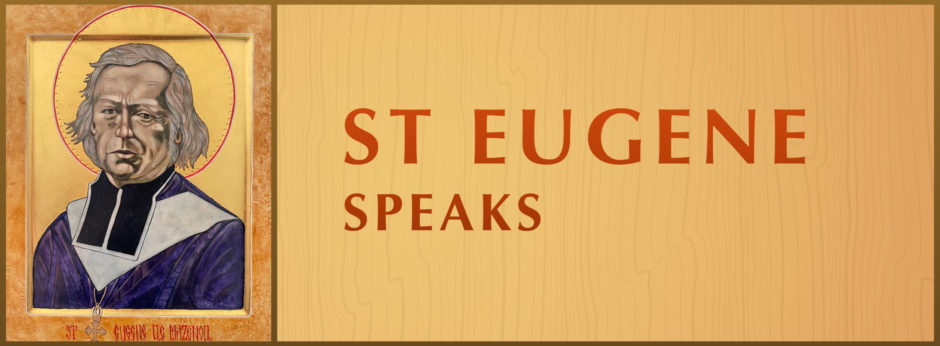Can I forget the bitter tears that the sight of the Cross brought streaming from my eyes one Good Friday?
Tears of sorrow because:
I had looked for happiness outside of God and for too long with resulting unhappiness.
Tears that changed into expressions of peace and joy as he realized how much God loved him:
Blessed, a thousand times blessed, that he, this good Father, notwithstanding my unworthiness, lavished on me all the richness of his mercy.
Retreat Journal, December 1814, O.W. XV n.130
With that experience of God’s love for him on the Cross, Eugene’s life was transformed. The symbol of the Cross became the vehicle of the invitation of Jesus Christ to give “all for God” and to invite others to that same love. The Cross was the invitation to oblation and the sign of oblation.
Consequently, the only distinctive sign possible for the Missionary was the Cross:
Their only distinctive mark will be the crucifix, which is proper to their ministry. They will always wear on their chest, inserted in the cincture and it hanging from a cord to which it is attached.
1818 Rule, Part Two, Chapter One. Regarding other principal observances
Today, “our only distinctive sign is the Oblate cross” (C64) because it was the only distinctive sign possible for Eugene:
The Oblate cross which is received at perpetual profession is a constant reminder of the love of the Saviour who wishes to draw all hearts to himself and sends us out as his co-workers.
CC&RR, Constitution 63
It is beautiful to see that as people feel called to share in Eugene’s vision and mission as laity, as religious or as priests – it is the Oblate Cross that becomes the uniting and transforming symbol of their quest.
“Bear the Cross cheerfully and it will bear you.” Thomas Kempis

This strikes to the very heart of what draws me to the Oblates of Mary Immaculate and the Mazenod family.
I too looked for happiness outside of God and for far too long – in a bottle – resulting in unimaginable unhappiness and eventual “death.”
Unlike Eugene, I never had a single epiphany moment that suddenly changed my life, but rather was dragged by My Father, kicking and screaming like a spoiled child, to this new place where He wanted/needed me.
And yes, now I am ” Blessed, a thousand times blessed, that he, this good Father, notwithstanding my unworthiness, lavished on me all the richness of his mercy.”
I surely will never be qualified to wear “the symbol” but I have my tiny wooden cross and medal of St. Eugene on a chord around my neck as a constant reminder of who and what I am and what this life is all about.
Once again, we are re-authoring and putting into today language the “cross”. For it is both fact and metaphor. Fact as the instrument of death for Jesus and metaphor for; love, letting go and lifting up for us. In a meditation I read today, Heinrich Zimmer said, “The best things cannot be talked about, and the second best things are almost always misunderstood.” (On the Threshold of Transformation: Daily Meditations for Men, Richard Rohr, OFM) This calls me to silence and presence.
The Oblate Cross is like that. I know it means family, relationship, it means tradition, it means life and love and all the rest. And when I see it worn, be it the large profession cross or the small one we ware daily I know we are family. And the de Mazenodian Family is large and getting larger as the charism is embraced by so many more-what a gift to share with sisters and brother associate’s/or as referred to in one of the talks at the chapter LOMI.
Thank you Frank for this sharing today.
I do so love what you wrote, particularly “It is beautiful to see that as people feel called to share in Eugene’s vision and mission as laity, as religious or as priests – it is the Oblate Cross that becomes the uniting and transforming symbol of their quest.” The Cross has always been an incredible sign / symbol of God’s love – it has been much more than the pain and suffering, the messiness and the “death” (which we seem to have such trouble with and which we want often to avoid rather than embrace). It is as you say, the symbol of transformation, the symbol of glorious and incredible, immeasurable love.
” …. it is the Oblate Cross that becomes the uniting and transforming symbol of their quest.” As I read this I am taking it to mean that it is not only in seeing the Oblate Cross – but as in “wearing” it – religious Oblates as well as Oblate Associates. Not a view of all for sure but a view held by myself and some of the Oblates I am in community with. I wear it with incredible joy and pride, with gratitude and immense hope.